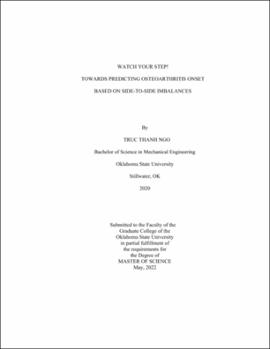| dc.contributor.advisor | Hausselle, Jerome | |
| dc.contributor.author | Ngo, Truc Thanh | |
| dc.date.accessioned | 2023-03-21T21:03:45Z | |
| dc.date.available | 2023-03-21T21:03:45Z | |
| dc.date.issued | 2022-05 | |
| dc.identifier.uri | https://hdl.handle.net/11244/337145 | |
| dc.description.abstract | Osteoarthritis (OA) is a debilitating disease characterized by the erosion of articular cartilage at the extremity of bones. OA contributes to economic burdens, pain, and abnormal locomotion to accommodate for loss of protective cartilage. Since there is no cure for OA, mitigating disease onset can relieve the lives of millions of people who are at higher risk of OA such as females and overweight people. | |
| dc.description.abstract | The progressive disappearance of protective cartilage leads to bone-on-bone contact at the joints, which is aggravated by higher-than-normal joint contact forces. Although OA can affect any joint, the primary weight-bearing joints of the lower body, i.e. hip, knee, and ankle, suffer the most impairment. Thus, investigating walking behavior can aid in detecting abnormal locomotion that may lead to OA. | |
| dc.description.abstract | The objectives of this study were (1) to investigate a simple mechanical model’s ability to accurately reproduce measured gait kinetics and (2) to propose and evaluate novel parameters to supplement current noninvasive clinical tools for gait analysis. | |
| dc.description.abstract | For a total of forty healthy subjects, kinematic and kinetic parameters were optimized for 300 consecutive steps to fit experimental vertical ground reaction force data measured during treadmill walking. Using an existing inverted spring-loaded pendulum with a spring-loaded ankle, we assessed the variations in leg and ankle stiffnesses during gait. We quantified bilateral lower limb symmetry, gait regularity, and gait variability based on the optimized stiffness values, which highlighted gait disparities between males and females, and between different body mass index categories. | |
| dc.description.abstract | Our results confirmed that all subjects exhibited a certain amount of side-to-side asymmetry, irregularity, and variability in their leg and ankle stiffnesses during walking. Furthermore, large inter-subject variability indicated that our simple model could detect idiosyncratic gait patterns and therefore estimate potential imbalances in gait patterns. Future studies to test these walking assessments with accelerations as input parameters, which are easier to measure in a clinical setting, can improve current screenings for OA. | |
| dc.format | application/pdf | |
| dc.language | en_US | |
| dc.rights | Copyright is held by the author who has granted the Oklahoma State University Library the non-exclusive right to share this material in its institutional repository. Contact Digital Library Services at lib-dls@okstate.edu or 405-744-9161 for the permission policy on the use, reproduction or distribution of this material. | |
| dc.title | Watch your step! Towards predicting osteoarthritis onset based on side-to-side imbalances | |
| dc.contributor.committeeMember | Madihally, Sundararajan | |
| dc.contributor.committeeMember | Manimala, James | |
| dc.contributor.committeeMember | Xiang, Yujiang | |
| osu.filename | Ngo_okstate_0664M_17605.pdf | |
| osu.accesstype | Open Access | |
| dc.type.genre | Thesis | |
| dc.type.material | Text | |
| dc.subject.keywords | gait | |
| dc.subject.keywords | sample entropy | |
| dc.subject.keywords | spring-loaded inverted pendulum | |
| dc.subject.keywords | stiffness | |
| dc.subject.keywords | symmetry | |
| dc.subject.keywords | variability | |
| thesis.degree.discipline | Mechanical and Aerospace Engineering | |
| thesis.degree.grantor | Oklahoma State University | |
